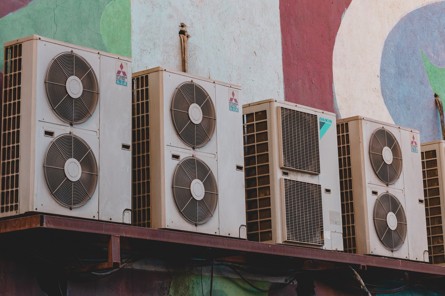It’s rarely a fun home maintenance task, but checking to see if your ductwork is leaking can be a vital step in saving energy, reducing allergens, and preventing mold growth.
It’s not always obvious where ducts leak, and even if you find the source, fixing it can be a lot of hassle. Thankfully, Hurliman’s technicians are experts in HVAC system maintenance and repair, so we have plenty of expertise in knowing what to look for.
If you’re wondering “how can I test my air conditioning ducts for leaks”, we’ve got you covered. With our step-by-step guide explaining how to check your ductwork for leaks, you’ll be able to identify any problems before they become expensive issues.
How to tell if Air Ducts are Leaking
-
Check the temperature – Checking the temperature is the first step toward knowing whether your air duct leaks. You should look for any unusual changes in the temperature of your air conditioning unit. Contact an HVAC professional to fix the problem if you find any.
-
Look for condensation – Condensation is another sign of leakage. Condensation occurs when moisture gets trapped inside the ductwork, damaging the duct system.
-
Listen carefully – Noise is created due to air leaks in the ductwork. Listen carefully to see if you can hear any whistling noise coming from the ductwork. If you hear any noise, you should immediately call a professional to repair the leak.
-
Check for mold – Mold is another sign of leakage in the ductwork. Mold grows in damp areas, which is harmful to your indoor air quality. Therefore, it is essential to clean the area around the ductwork regularly.
-
Check for water stains – Water stains occur when water enters the air ducts through cracks or holes. Check for any cold spots because they can cause severe damage to the air duct.
Step-by-step Guide on how to Inspect Your Ducts for Leaks
The following steps outline how to find leaks in ductwork.
-
Check the Location of Your Ductwork
Before you start looking for air leaks, make sure that you know where your ducts are located. It’s important to note that more than one duct may run through your house.
For example, you might have two air ducts. One system runs from the furnace to the vents, while the other runs directly into the attic.
-
Look for Cracks or Holes
Once you know where your ductwork is located, look for cracks or holes. These could be signs of an air duct leak. Cracks are usually caused by corrosion, which is often a result of metal parts of your duct getting wet and losing their strength. If you notice any cracks in the ductwork, you should contact an HVAC professional to repair them.
-
Use a Smoke Pencil to Find Leaks in the Ductwork
Once you have checked the location of your ductwork and inspected the ductwork for cracks, learning how you can test your air conditioning ducts for leaks becomes easier using a smoke pencil.
You should move the smoke pencil over your ducts. When you do this, you’ll notice a smoke disturbance where there is a leak. This method is ideal for finding leaks in smaller ducts, such as those found in attics or crawl spaces. However, it isn’t suitable for larger ducts.
-
Check for Signs of Duct Tape
Duct tape is a common product often used as a DIY method to fix the duct around the house. But you shouldn’t use it to patch up ducts because it won’t hold up long term. When inspecting your duct, you should check for duct tape as this is often the reason for a leak, especially in older homes. Our team inspects your duct by first looking for duct tape, and if we see any, we remove it and seal the ducts properly.
-
Blow Air into the Ducts
If you want to find any leaks in your ductwork easily, turn on your heating and air conditioning system to full power. This will create more airflow and make it easier to pinpoint where the air comes out at high speed.
-
Fix the Leak
If you find a leak, you should fix it immediately. Otherwise, you risk causing more damage to your ducts. Repeat these steps on how to check your ductwork for leaks until you have inspected every area of your house.
Don’t Forget About The Attic
You should also inspect your attic for leaks because it has direct access to the outside environment. As a result, it can become humid, increasing the chances of mold growth.
Mold growth can cause health problems and ruin your property value. Therefore, it’s important to keep your attic dry. To do so, you can also install dehumidifiers.
We recommend hiring professionals to perform attic insulation services. They will ensure that your attic stays dry throughout the year.
For more information about your duct maintenance in Spokane, WA, and surrounding areas, call Hurliman heating today. Our team of highly trained and experienced technicians offers affordable duct inspection services.
Why is it Important to Check Your Ductwork for Leaks
Preventing Mold Growth
Mold growth is one of the most common problems caused by leaks in ducts. Mold grows quickly in warm, damp environments. And if you live in a humid area, chances are you’ll find mold growing in your ducts. The mold can cause health issues such as allergies, asthma, and respiratory infections.
Improving Indoor Air Quality
When ducts leak, they let out stale air. Stale air contains dust particles and bacteria. These particles and bacteria can cause respiratory illnesses. Regularly checking your ducts helps to keep the air clean.
Saving Energy Bills
Leaking ducts can reduce the efficiency of your HVAC system. Leaks can cause air to escape from the vents. This reduces the amount of heat that enters the room. Also, the airflow decreases. This results in higher energy bills. By regularly inspecting your ducts, you can save energy.
Dampness can Lead to Structural Problems
Leaking ducts can also cause structural problems. For example, moisture can seep into electrical wiring and cause short circuits. This can result in fire hazards.
Avoiding Structural Damage
Structural damage can occur due to leaking air ducts. This can happen when water gets trapped inside ducts, resulting in rusting of metal parts. Therefore, regular inspection of the duct system is necessary.
If you’ve noticed any signs of leaks in your air ducts, contact us immediately. We’ll inspect your ducts and give you additional information on how to check your ductwork for leaks.






